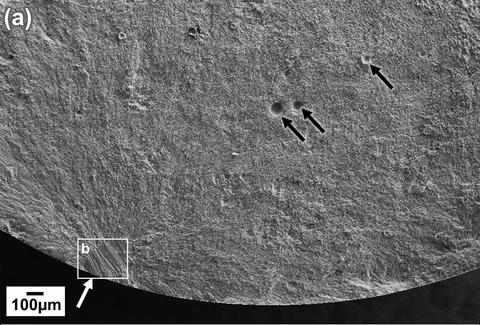NIST Releases Findings from the NIST/ASTM Workshop on Mechanical Behavior of Additive Manufacturing Components

Fracture surface of AM (electron beam melting) titanium alloy (Ti-6Al-4V) high-cycle fatigue fracture surface showing crack initiation at internal lack-of-fusion defect (white arrow). [4]
The worldwide market for additive manufacturing (AM) products and services is projected to exceed US$6.5 billion by 2019 [1]. Despite this prediction, there are no metal AM parts currently being used in any fatigue or fracture critical applications [2, 3]. As a result, ASTM and NIST held a workshop May 4-5, 2016, during the ASTM 2016 Committee Week in San Antonio, TX to determine and prioritize the research, standards, and data needs required to overcome the barriers to the acceptance of AM parts for these important applications. This meeting brought together over 150 representatives from industry, academia, and government (research and regulatory) agencies who presented, discussed, evaluated, and prioritized research and standardization needs to enable the use of AM parts in fatigue and fracture critical applications. The report of this workshop, Findings from the NIST/ASTM Workshop on Mechanical Behavior of Additive Manufacturing Components, has been released and is available for download. This report should help guide the planning of research and standards development to enable the use of AM parts while avoiding fatigue and fracture failures.
REFERENCES
[1] Caffrey, T. and T. Wohlers, 3D printing and Additive Manufacturing State of Industry. 2015.
[2] Gorelik, M. Additive Manufacturing in the Context of Structural Integrity. in NIST/ASTM Workshop on Mechanical Behavior of Additive Manufactured Components.
[3] Seifi, M., A. Salem, J. Beuth, O. Harrysson, and J.L. Lewandowski, Overview of Materials Qualification Needs for Metal Additive Manufacturing. JOM, 2016. 68(3): p. 747-764.
[4] Hrabe, N., T. Gnaupel-Herold, and T. Quinn, Fatigue Properties of a Titanium Alloy (Ti-6Al-4V) Fabricated via Electron Beam Melting (EBM): Effects of Internal Defects and Residual Stress. International Journal of Fatigue, 2017. 94: p. 202-210.

